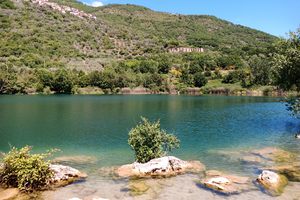Lake of Cutilia in Vasche, Italy

The Lake of Cutilia also known as the Paterno Lake was sacred to the Sabine people.
Roman historians described a floating island with a temple dedicated to the oracular cult of the Sabine Goddess Vacuna, a fertility goddess who protected the waters. The lake was later exploited by the Romans, particularly by two locally-born Roman emperors, Vespasian and Titus.
The region is located strategically along an ancient road, the Via Salaria which connects Rome to the Adriatic Sea, is actually a geological wonder. Cold waters in the area form sinkholes, sulfur-rich springs, and small lakes (such as the spring that swallowed up the nearby abandoned church of San Vittorino).
In the years to follow, the area became a thermal spa that Romans called Vicus Aquae Cutiliae. Several ruins were discovered in the area such as Titus’s villa, and the thermal buildings that were constructed during the reign of Vespasian.
The lake was described by several Roman authors, such as Macrobius, Varro, and Pliny. Some Roman historians also identify the lake of Paterno as the legendary “umbilicus Italiae,” or the “navel of Italy.”





